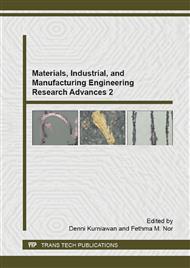p.260
p.266
p.271
p.276
p.281
p.286
p.290
p.296
p.301
Biopolymeric Adsorbent for the Removal of Methylene Blue: Characterizations, Equilibrium Isotherms and Kinetic Studies
Abstract:
Crosslinked Sago Starch (CSS) was prepared by crosslinking native starch with Sodium Trimetaphosphate. As a biodegradable adsorbent, CSS was used to remove methylene blue (MB) from the aqueous solution based on its characterization, including the granule morphology, crystalline nature and molecular structure. The adsorption capacity of CSS was evaluated as a function of pH, adsorbent dosage, initial concentration and time. It was favorable for adsorption under condition of neutral and at high initial concentration. The adsorption capacity trend was decreased with increasing the adsorbent dosage. The equilibrium isotherms were conducted using Langmuir, Freundlich and Tempkin model. It has been demonstrated that the better agreement was Langmuir isotherm with correlation coefficient of 0.99, equilibrium adsorption capacity of 3.75 mg g-1, chi-square test, χ2 of 0.03% and corresponding contact time of 4 hours. The pseudo-first-order, pseudo-second-order and intra-particle diffusion were used to fit adsorption data in the kinetic studies. And results showed that the adsorption kinetics was more accurately described by the pseudo-second-order model with correlation coefficient, R2 of 0.99 and standard deviation, SSE of 0.12%. The obtained results suggest that CSS could be promising candidates as an adsorbent for dye removal.
Info:
Periodical:
Pages:
281-285
Citation:
Online since:
October 2015
Authors:
Keywords:
Price:
Сopyright:
© 2015 Trans Tech Publications Ltd. All Rights Reserved
Share:
Citation:


